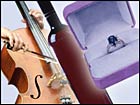|
Insuring your Picasso
|
 |
January 18, 2002: 1:06 p.m. ET
If you own high-ticket items, you may need an extra dose of insurance.
By Annelena Lobb
|
|  |
 |
|
| |  |
 |


|
|
|
|

|
|
WTC leaseholder sued
Insurers pump up prices on car policies
|
| |
 |
|
NEW YORK (CNN/Money) - Your homeowners' insurance policy offers coverage for many accidents that could befall your most prized possessions. But what if your most prized possessions cost more than a few thousand dollars? Say, an expensive engagement ring, a collection of fine art, or a Stradivarius or two. You might need additional coverage. And the time to find out isn't after you've submitted a claim to your insurance company.
Your homeowners' policy may have specific dollar limits on certain types of expensive items, said Jeanne Salvatore, vice-president of consumer affairs at the Insurance Information Institute. Some have dollar limits on the amount they'll reimburse you if your items are stolen. Some have dollar limits for these items in the case of any type of disaster.
"Every homeowners' policy is limited in some way," said Mary Ann Avnet, a spokeswoman for Chubb Group, an insurer specializing in high-end homes and their contents. "If you have jewelry, silver, cameras, guns or expensive collectibles, you need to make an educated judgment as to whether you want to insure them separately from your homeowners' policy."
Getting started
Take stock of the high-ticket items you have, and call your insurance agent to see exactly how you are and are not covered. You may need to buy what the insurance industry calls a "floater", or a policy that specifically insures these articles. If you choose to rely solely on homeowners' insurance, you may not have enough coverage to replace your valuables - and you'll have to pay a deductible before it kicks in at all.
"Unlike a usual homeowners' policy where you have coverage on a named-peril basis, a personal articles policy or floater has all-risk coverage," said Jan Weyrich, an underwriting consultant for State Farm insurance. "You can take out one policy and cover a variety of items - jewelry, fine arts, antiques, paintings, sculptures, coin collections, or furs, to name a few."
Insuring your baubles
Appropriate coverage depends on the usual risks posed to the type of item you intend to insure. People want a policy with as few exclusions as possible and that allows them to move the item from place to place.
If you own a high-end or antique car, for example, companies like Chubb Group offer "agreed value" policies. Most car owners know their purchase depreciates the minute they drive it off the lot. If you bought a $100,000 car and an agreed value policy worth $65,000, the company would pay you that amount if you lost the car for any reason. (With an ordinary auto insurance policy, you would start to negotiate the value of the car with the insurer after it was totaled and according to the book value of the automobile.)
If you own expensive jewelry, one thing you may want to request is "mysterious disappearance" coverage. If you leave the house wearing a diamond tennis bracelet, and arrive at work to find that it's gone, you may not have coverage under your homeowners' policy, since that event doesn't qualify as theft, Avnet said. "Far more jewelry is lost than stolen," she added. You should also ensure you have parent-set coverage. If you lose one earring and there is no way to get an exact match, parent-set coverage ensures you get a full set or series of items.
If you are a collector, you may have different risks to assess. Make sure you know you are insured against typical risks for the kind of collection you have. If you collect porcelain, you need to ensure you are covered for breakage. Antique collectors who travel, for example, needs a policy that gives automatic protection for items they buy abroad even before they bring the item back home.
"If a client goes to the Netherlands and buys a beautiful antique table and wants to have it shipped back to the States, they need to know that their purchases abroad are covered," Avnet said.
If you're insuring fine art, the most important issue, again, is documenting value before any loss occurs, said Dr. Dietrich von Frank, CEO and president of AXA Art Insurance Corp.
"It's easy when you start collecting," von Frank said. "It may be a simple matter of saving receipts. But if you inherit art, for instance, you need to make sure it's being assessed and valued properly."
Art insurance premiums are calculated according to probable maximum losses. "It's more likely that three paintings in one apartment will be wiped out in a fire than a $100 million collection in several locations will be destroyed at once," von Frank said.
Three types of policies are typically used to insure fine art. One is an agreed value policy, typically used for smaller collections. A loss limit policy sets a maximum, according to an appraiser's evaluation, that the insurer pays if the entire collection is lost. The third is a current market value policy, which requires that you have art reappraised every two years. You set an overall loss limit, up to which current market value of each piece of art will be paid. If your collection appreciates considerably, you can increase your loss limit.
The most important thing to do in any case is to ascertain and set values ahead of time for these pricey items - whether it's a limit on a large policy for several items, or a set value for each one. "You don't want a situation where you have to prove that you had a $10,000 Barbie doll collection after it's destroyed," Salvatore said. 
|
|
|
|
|
|

|

